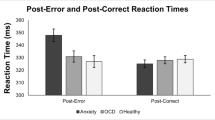Abstract
This study addresses the question of why some highly anxious individuals exhibit excessive levels of compulsive checking behavior while other do not. To this end, nonclinical samples of compulsive checkers (n=19), (nonchecking) anxious controls (n=16), and (nonchecking) nonanxious controls (n=12) were compared on a variety of cognitive, behavioral, personality, and affective measures hypothesized to differentiate checkers from anxious controls. Results indicated that checkers exhibited higher levels of perfectionism and worry, and demonstrated greater cognitive impairment on the Wisconsin Card Sorting Test. Furthermore, performance and subjective experiences of performance appeared to be mediated by perfectionism and worry. Findings suggest that both personality and cognitive variables are important correlates of the form of anxiety-related symptomatology.
Similar content being viewed by others
References
American Psychiatric Association. (1987).Diagnostic and statistical manual of mental disorders (3rd ed., rev.). Washington, DC: Author.
Beck, A. T., Ward, C. H., Mendelson, M., Mock, J., & Erbaugh, J. (1961). An inventory for measuring depression.Archives of General Psychiatry, 4, 561–571.
Berg, E. A. (1948). A simple objective technique for measuring flexibility in thinking.Journal of General Psychology, 39, 15–22.
Borkovec, T. D., Metzger, R. L., & Pruzinsky, T. (1986). Anxiety, worry and the self. In H. Hartman & K. R. Blankstein (Eds.),Perception of self in emotional disorder and psychotherapy. New York: Plenum Press.
Broadbent, D., Cooper, P., Fitzgerald, P., & Parkes, K. (1982). The cognitive failures questionnaire (CFQ) and its correlates.British Journal of Clinical Psychology, 21, 1–16.
Brown, T. A., Moras, K., Zinbarg, R. E., & Barlow, D. H. (1993). Diagnostic and symptom distinguishability of generalized anxiety disorder and obsessive-compulsive disorder.Behavior Therapy, 24, 227–240.
Foa, E. B., Ilai, D., McCarthy, P., Shoyer, B. G., & Murdock, T. (1993). Informational processing in obsessive-compulsive disorder.Cognitive Therapy and Research, 17, 173–189.
Foa, E. B., & McNally, R. J. (1986). Sensitivity to feared stimuli in obsessive-compulsives: A dichotic listening analysis.Cognitive Therapy and Research, 10, 477–485.
Foa, E. B., Steketee, G., Grayson, J. B., Turner, R. M., & Latimer, P. R. (1984). Deliberate exposure and blocking of obsessive-compulsive rituals: Immediate and long-term effects.Behavior Therapy, 15, 450–472.
Freeston, M. H., Ladouceur, R., Rheaume, J., Letarte, H., Gagnon, F., & Thibodeau, N. (1994). Self-report of obsessions and worry.Behaviour Research and Therapy, 32, 29–36.
Frost, R. O., Marten, P., Lahart, C., & Rosenblate, R. (1990). The dimensions of perfectionism.Cognitive Therapy and Research, 14, 449–468.
Frost, R. O., Sher, K. J., & Geen, T. (1986). Psychopathology and personality characteristics of nonclinical compulsive checkers.Behaviour Research and Therapy, 24, 133–143.
Frost, R. O., Steketee, G., Cohn, L., & Griess, K. (1994). Personality traits in subclinical and non-obsessive-compulsive volunteers and their parents.Behaviour Research and Therapy, 32, 47–56.
Goodwin, A. H., & Sher, K. J. (1992). Deficits in set-shifting ability in nonclinical compulsive checkers.Journal of Psychopathology and Behavioral Assessment, 14, 81–92.
Gotlib, I. H. (1984). Depression and general psychopathology in university students.Journal of Abnormal Psychology, 93, 19–30.
Harris, M. E. (1990).Wisconsin Card Sorting Test: Computerized version. Version 1.0 (Computer program and manual, Item No. D-1600-CP). Odessa, FL: Psychological Assessment Resources.
Hodgson, R., & Rachman, S. (1977). Obsessive-compulsive complaints.Behaviour Research and Therapy, 15, 389–395.
Hollon, S. D., & Kendall, P. C. (1980). Cognitive self-statements in depression: Development of an automatic thoughts questionnaire.Cognitive Therapy and Research, 4, 383–395.
Meyer, T. J., Miller, M. L., Metzger, R. L., & Borkovec, T. D. (1990). Development and validation of the penn state worry questionnaire.Behaviour Research and Therapy, 28, 487–495.
Rachman, S., & deSilva, P. (1978). Abnormal and normal obsessions.Behaviour Research and Therapy, 16, 233–238.
Rachman, S., & Hodgson, R. (1980).Obsessions and compulsions. Englewood Cliffs, NJ: Prentice-Hall.
Rasmussen, S. A., & Eisen, J. L. (1990). Epidemiology and clinical features of obsessive-compulsive disorder. In M. A. Jenike, L. Baer, & W. E. Minichiello (Eds.),Obsessive-compulsive disorders: Theory and management (2nd ed., pp. 10–27). Chicago: Year Book Medical Publishers.
Rotter, J. B. (1966). Generalized expectancies for internal versus external control of reinforcement.Psychological Monographs, 80, 1–28.
Rubenstein, C. S., Peynircioglu, Z. F., Chambless, D. L., & Pigott, T. A. (1993). Memory in sub-clinical obsessive-compulsive checkers.Behaviour Research and Therapy, 31, 759–765.
Salkovskis, P. M., & Harrison, J. (1984). Abnormal and normal obsessions—a replication.Behaviour Research and Therapy, 22, 549–552.
Sher, K. J., Frost, R. O., Kushner, M., Crews, T. M., & Alexander, J. E. (1989). Memory deficits in compulsive checkers: Replication and extension in a clinical sample.Behaviour Research and Therapy, 27, 65–69.
Sher, K. J., Frost, R. O., & Otto, R. (1983). Cognitive deficits in compulsive checkers: An exploratory study.Behaviour Research and Therapy, 21, 357–363.
Sher, K. J., Mann, B., & Frost, R. O. (1984). Cognitive dysfunction in compulsive checkers: Further explorations.Behaviour Research and Therapy, 22, 493–502.
Sher, K. J., Martin, E. D., Raskin, G., & Perrigo, R. (1991). Prevalence of DSM-III-R disorders among nonclinical compulsive checkers and noncheckers in a college student sample.Behaviour Research and Therapy, 29, 479–483.
Spielberger, C., Gorsuch, R., & Lushene, R. (1970).STAI manual. Palo Alto, CA: Consulting Psychologists Press.
Tallis, F., & DeSilva, P. (1992). Worry and obsessional symptoms: A correlational analysis.Behaviour Research and Therapy, 30, 103–105.
Author information
Authors and Affiliations
Rights and permissions
About this article
Cite this article
Gershuny, B.S., Sher, K.J. Compulsive checking and anxiety in a nonclinical sample: Differences in cognition, behavior, personality, and affect. J Psychopathol Behav Assess 17, 19–38 (1995). https://doi.org/10.1007/BF02229201
Accepted:
Issue Date:
DOI: https://doi.org/10.1007/BF02229201




